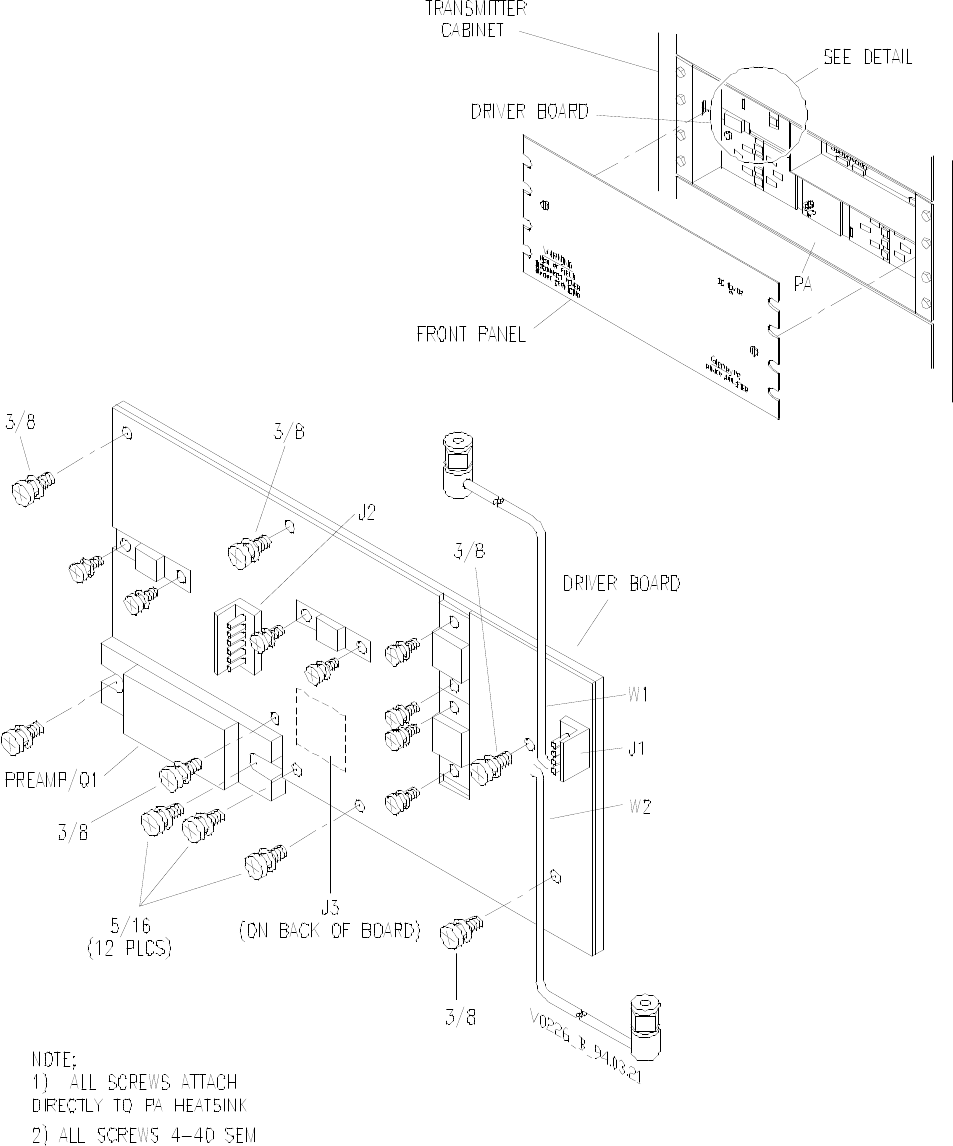Glenayre Electronics GL-T8600-CN Base Station User Manual Users manuall part 3
Glenayre Electronics Inc Base Station Users manuall part 3
Contents
- 1. Users manual part 1
- 2. Users manual part 2
- 3. Users manuall part 3
- 4. Users manual part 4
- 5. Users manual part 5
Users manuall part 3
Print Date: 12/17/96 Copyright © 1996 Glenayre
250-Watt Gold Line Power Amplifier Issue 1, Rev. D: 10/21/96
Specifications subject to change without notice
Copyright © 1996 Glenayre
All rights reserved. No part of this work may be reproduced or copied in any form or by
any means—graphic, electronic, or mechanical, including photocopying, recording,
taping, or information-retrieval system—without written permission of Glenayre.
500-Watt, 900-MHz Power Amplifier
USER MANUAL
PN 9110.00162 (old part number =916-8600-004)
REV D
RELEASED
250-Watt Gold Line Power Amplifier Glenayre Document Number: 9110.00162
Document Change Record Issue 1, Rev. D: 10/21/96
Copyright © 1996 Glenayre Print Date: 12/17/96
Document Change Record
Revision: B
Date: 02/01/96
Changes: new format
Issue: Rev C
Date: 05/24/96
Changes: new RF output specifications
Issue: Rev. D
Date: 05/30/96
Changes: new RF output specifications

Glenayre Document Number: 9110.00162 250-Watt Gold Line Power Amplifier
Issue 1, Rev. D: 10/21/96 Table of Contents
Print Date: 12/17/96 Copyright © 1996 Glenayre Page: -i
Table of Contents
1 GENERAL . . . . . . . . . . . . . . . . . . . . . . . . . . . . . . . . . . . . 1-1
1.1 Manual Scope . . . . . . . . . . . . . . . . . . . . . . . . 1-1
1.2 Applicable Documents. . . . . . . . . . . . . . . . . . . . . 1-1
1.3 Manual Sections . . . . . . . . . . . . . . . . . . . . . . . 1-1
2 SPECIFICATIONS . . . . . . . . . . . . . . . . . . . . . . . . . . . . . . . . 2-1
3 DESCRIPTION . . . . . . . . . . . . . . . . . . . . . . . . . . . . . . . . . . 3-1
3.1 Introduction . . . . . . . . . . . . . . . . . . . . . . . . . 3-1
3.2 Physical Description. . . . . . . . . . . . . . . . . . . . . . 3-1
3.2.1 Mounting Provisions . . . . . . . . . . . . . . . . . . . . . . . .3-1
3.2.2 PA Front. . . . . . . . . . . . . . . . . . . . . . . . . . . . . . .3-1
3.2.2.1 Driver Board . . . . . . . . . . . . . . . . . . . . . .3-2
3.2.2.2 Combiner Board. . . . . . . . . . . . . . . . . . . . .3-2
3.2.2.3 Metering Board . . . . . . . . . . . . . . . . . . . . .3-2
3.2.3 PA Rear . . . . . . . . . . . . . . . . . . . . . . . . . . . . . . .3-2
3.2.3.1 Isolator . . . . . . . . . . . . . . . . . . . . . . . . .3-2
3.2.3.2 PA Boards. . . . . . . . . . . . . . . . . . . . . . . .3-5
3.2.3.3 Equipment Connectors . . . . . . . . . . . . . . . . .3-5
3.3 Functional Description . . . . . . . . . . . . . . . . . . . . . 3-5
3.3.1 RF Amplifier . . . . . . . . . . . . . . . . . . . . . . . . . . . .3-5
3.3.2 Isolator . . . . . . . . . . . . . . . . . . . . . . . . . . . . . . .3-5
3.3.3 Metering. . . . . . . . . . . . . . . . . . . . . . . . . . . . . . .3-5
4 INSTALLATION AND SETUP . . . . . . . . . . . . . . . . . . . . . . . . . 4-1
4.1 Precautions and Hazards . . . . . . . . . . . . . . . . . . . . 4-1
4.2 Test Equipment and Tools Required . . . . . . . . . . . . . . . 4-1
4.3 Installation . . . . . . . . . . . . . . . . . . . . . . . . . 4-1
4.3.1 Rack Positioning . . . . . . . . . . . . . . . . . . . . . . . . . .4-1
4.3.2 Rack Grounding. . . . . . . . . . . . . . . . . . . . . . . . . . .4-2
4.3.3 Equipment Inspection . . . . . . . . . . . . . . . . . . . . . . . .4-2
4.3.4 Equipment Cabling . . . . . . . . . . . . . . . . . . . . . . . . .4-2
4.3.5 Equipment Mounting . . . . . . . . . . . . . . . . . . . . . . . .4-2
4.3.6 Ultimate Disposition . . . . . . . . . . . . . . . . . . . . . . . .4-2
4.4 Setup. . . . . . . . . . . . . . . . . . . . . . . . . . . . 4-3
5 OPERATION . . . . . . . . . . . . . . . . . . . . . . . . . . . . . . . . . . . 5-1
5.1 Controls and Indicators . . . . . . . . . . . . . . . . . . . . 5-1
5.2 Operation . . . . . . . . . . . . . . . . . . . . . . . . . . 5-1
250-Watt Gold Line Power Amplifier Glenayre Document Number: 9110.00162
Table of Contents Issue 1, Rev. D: 10/21/96
Page: -ii Copyright © 1996 Glenayre Print Date: 12/17/96
5.2.1 Turn PA On and Off . . . . . . . . . . . . . . . . . . . . . . . . 5-1
5.2.2 Turn Fan On and Off . . . . . . . . . . . . . . . . . . . . . . . . 5-1
5.2.3 Key and Unkey PA . . . . . . . . . . . . . . . . . . . . . . . . . 5-1
6 THEORY OF OPERATION. . . . . . . . . . . . . . . . . . . . . . . . . . . 6-1
6.1 Power Distribution . . . . . . . . . . . . . . . . . . . . . . 6-1
6.1.1 Primary Power . . . . . . . . . . . . . . . . . . . . . . . . . . . 6-1
6.1.1.1 Metering Board +25V Signal Flow. . . . . . . . . . . 6-1
6.1.1.2 Power Amplifiers +25V Signal Flow. . . . . . . . . . 6-1
6.1.2 Secondary Power . . . . . . . . . . . . . . . . . . . . . . . . . . 6-2
6.1.2.1 Metering Board +13.5V Signal Flow. . . . . . . . . . 6-2
6.1.2.2 Preamplifier Module +13.5V Signal Flow . . . . . . . 6-2
6.1.3 Fan Power. . . . . . . . . . . . . . . . . . . . . . . . . . . . . . 6-2
6.2 RF Distribution . . . . . . . . . . . . . . . . . . . . . . . 6-3
6.2.1 Driver Board RF Flow . . . . . . . . . . . . . . . . . . . . . . . 6-3
6.2.2 PA Board RF Flow . . . . . . . . . . . . . . . . . . . . . . . . . 6-4
6.2.3 Combiner Board RF Flow . . . . . . . . . . . . . . . . . . . . . 6-4
6.2.4 Isolator RF Flow . . . . . . . . . . . . . . . . . . . . . . . . . . 6-4
6.3 Control Distribution . . . . . . . . . . . . . . . . . . . . . 6-5
6.3.1 AGC Signal Flow. . . . . . . . . . . . . . . . . . . . . . . . . . 6-5
6.3.2 Multiplexer Control Signal Flow . . . . . . . . . . . . . . . . . . 6-5
6.4 Status Distribution . . . . . . . . . . . . . . . . . . . . . . 6-5
6.4.1 Mux Analog Status Signal Flow . . . . . . . . . . . . . . . . . . 6-6
6.4.2 PA Fault Signal Flow. . . . . . . . . . . . . . . . . . . . . . . . 6-6
7 MAINTENANCE . . . . . . . . . . . . . . . . . . . . . . . . . . . . . . . . . 7-1
8 CHECKOUT AND TROUBLESHOOTING . . . . . . . . . . . . . . . . . . 8-1
9 REMOVAL AND REINSTALLATION . . . . . . . . . . . . . . . . . . . . 9-1
9.1 PA Chassis Removal and Reinstallation . . . . . . . . . . . . . 9-1
9.2 PA RF Module Removal and Reinstallation . . . . . . . . . . . . 9-1
9.3 Metering Board Removal and Reinstallation . . . . . . . . . . . . 9-1

Glenayre Document Number: 9110.00162 250-Watt Gold Line Power Amplifier
Issue 1, Rev. D: 10/21/96 List of Figures
Print Date: 12/17/96 Copyright © 1996 Glenayre Page: -iii
List of Figures
Figure 3-1 500-Watt, 900-MHz Power Amplifier
Front View . . . . . . . . . . . . . . . . . . . . . . . . . . . . . . . . 3-3
Figure 3-2 500-Watt, 900-MHz Power Amplifier
Rear View . . . . . . . . . . . . . . . . . . . . . . . . . . . . . . . . . 3-4
Figure 3-3 Simplified Block Diagram . . . . . . . . . . . . . . . . . . . . . . . . 3-6
Figure 5-1 Front-Panel View with Cover Removed . . . . . . . . . . . . . . . . . 5-2
Figure 6-1 500-Watt PA Interconnection Diagram. . . . . . . . . . . . . . . . . . 6-8
Figure 6-2 500-Watt PA Functional Diagram . . . . . . . . . . . . . . . . . . . . 6-9
Figure 6-3 500-Watt PA Detailed Functional Diagram . . . . . . . . . . . . . . .6-10
Figure 6-4 Metering Board Functional Diagram . . . . . . . . . . . . . . . . . . .6-12
Figure 9-1 PA Removal and Reinstallation. . . . . . . . . . . . . . . . . . . . . . 9-2
Figure 9-2 PA RF Module Removal and Reinstallation . . . . . . . . . . . . . . . 9-4
Figure 9-3 Metering Board Removal and Reinstallation . . . . . . . . . . . . . . . 9-6
250-Watt Gold Line Power Amplifier Glenayre Document Number: 9110.00162
List of Figures Issue 1, Rev. D: 10/21/96
Page: -iv Copyright © 1996 Glenayre Print Date: 12/17/96

Glenayre Document Number: 9110.00162 250-Watt Gold Line Power Amplifier
Issue 1, Rev. D: 10/21/96 List of Tables
Print Date: 12/17/96 Copyright © 1996 Glenayre Page: -v
List of Tables
Table 1-1 Applicable Documents . . . . . . . . . . . . . . . . . . . . . . . . . . 1-1
Table 1-2 Manual Sections . . . . . . . . . . . . . . . . . . . . . . . . . . . . . 1-2
Table 2-1 Power Amplifier Specifications. . . . . . . . . . . . . . . . . . . . . . 2-1
Table 3-1 PA Circuit Boards. . . . . . . . . . . . . . . . . . . . . . . . . . . . . 3-1
Table 4-1 Test Equipment Required. . . . . . . . . . . . . . . . . . . . . . . . . 4-1
Table 6-1 Multiplexer Analog Status Inputs. . . . . . . . . . . . . . . . . . . . . 6-7
250-Watt Gold Line Power Amplifier Glenayre Document Number: 9110.00162
List of Tables Issue 1, Rev. D: 10/21/96
Page: -vi Copyright © 1996 Glenayre Print Date: 12/17/96

Glenayre Document Number: 9110.00162 250-Watt Gold Line Power Amplifier
Issue 1, Rev. D: 10/21/96 GENERAL
Print Date: 12/17/96 Copyright © 1996 Glenayre Page: 1-1
1 GENERAL
1.1 Manual Scope
This manual provides information for the 500-watt, 900-MHz Gold Line power amplifier,
part number 265-0082-013. Also included is information for the optional triple isolator,
part number 7914.00010.
1.2 Applicable Documents
This manual is incomplete without additional Gold Line manuals. Refer to Table 1-1 for a
listing and function of these manuals.
1.3 Manual Sections
Table 1-2 lists the sections of this manual with a summary of their contents.
Table 1-1 Applicable Documents
document part number function
GL-T8500/T8600 system
manual
9110.00163 describes fully racked-up Gold
Line transmitter
VDT manual 9110.00164 describes PA control software
installed in exciter
exciter manual 9110.00172 describes exciter/PA control
equipment in transmitter
500-watt PA 9110.00162 this manual
power supply manual 9110.00159 describes 50A/90A power
supply equipment in transmitter
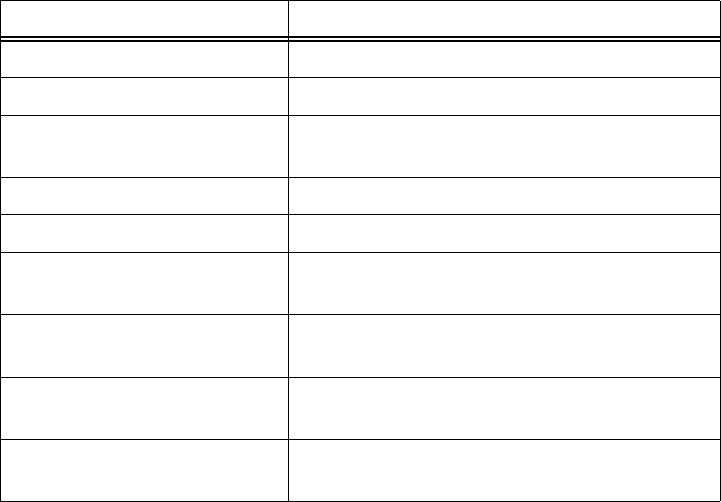
250-Watt Gold Line Power Amplifier Glenayre Document Number: 9110.00162
GENERAL Issue 1, Rev. D: 10/21/96
Page: 1-2 Copyright © 1996 Glenayre Print Date: 12/17/96
Table 1-2 Manual Sections
section contents
1. general introduction and purpose of manual
2. specifications significant measurements of power amplifier
3. description introduction and principal characteristics of power
amplifier
4. installation and setup initial installation and activation of power amplifier
5. operation operation of power amplifier
6. theory of operation detailed functional description of circuitry within
power amplifier
7. maintenance procedures to be performed on specific intervals to
maintain optimum performance of power amplifier
8. checkout and troubleshooting verification of proper operation, correction to proper
operation of power amplifier
9. removal and reinstallation replacement procedures for power amplifier and
selected subassemblies

Glenayre Document Number: 9110.00162 250-Watt Gold Line Power Amplifier
Issue 1, Rev. D: 10/21/96 SPECIFICATIONS
Print Date: 12/17/96 Copyright © 1996 Glenayre Page: 2-1
2 SPECIFICATIONS
Table 2-1 lists the significant equipment-level specifications for the Gold Line power
amplifier.
Table 2-1 Power Amplifier Specifications
measurement specification
height 8.75 in (22.23 cm)
width 19 in (48.3 cm)
depth 8 in (20.3 cm)
weight 26 lb (12 kg)
RF output power 200 - 600 watts
RF bandwidth 900 - 960 MHz
RF input power 200 - 400 mW
RF impedance 50 ohms
operating voltages 25 vdc, 25 Vdc, 13.5 Vdc
PA 25 Vdc current 72 mA - 33 A
fan 25 Vdc current 750 mA
13.5 Vdc current 3.3 A
ambient temperature -30° - +70° C
humidity 0 - 95% noncondensing
altitude to 10,000 ft (3050 m)
250-Watt Gold Line Power Amplifier Glenayre Document Number: 9110.00162
SPECIFICATIONS Issue 1, Rev. D: 10/21/96
Page: 2-2 Copyright © 1996 Glenayre Print Date: 12/17/96

Glenayre Document Number: 9110.00162 250-Watt Gold Line Power Amplifier
Issue 1, Rev. D: 10/21/96 DESCRIPTION
Print Date: 12/17/96 Copyright © 1996 Glenayre Page: 3-1
3 DESCRIPTION
3.1 Introduction
Figure 3-1, 500-Watt, 900-MHz Power Amplifier Front View, and Figure 3-2, 500-Watt,
900-MHz Power Amplifier Rear View, show the Gold Line power amplifier (PA). This is
a 500-watt PA intended for use in a GL-T8600 paging transmitter with an RF of 900 MHz
nominal. This PA is characterized by integrated monitoring devices that supply critical
status information to a Gold Line exciter/PA control (exciter). This exciter contains diag-
nostic software that can detect and report a faulty PA circuit board.
3.2 Physical Description
3.2.1 Mounting Provisions
The PA is mounted to the front of most standard 19-inch equipment racks by means of eight
screws. The front panel of the PA may by removed while the PA is mounted in the rack.
Two quarter-turn fasteners secure the front panel to the PA. Most PA circuit boards may be
replaced while the PA is mounted in the rack.
3.2.2 PA Front
Figure 5-1, Front-Panel View with Cover Removed, shows the front view of the PA with
the front panel removed. This exposes the RF and shielded compartments, which contain
the PA circuit boards. Table 3-1 lists the PA circuit boards.
3.2.2.1 Driver Board
The driver board contains the preamp module, the intermediate PA (IPA), and the PA
drivers (driver-1, driver-2, driver-3, and driver-4). These devices, in addition to one
resistor, are mounted directly on the PA heat sink. The driver board contains three connec-
tors: two on the front (J1 and J2) and one on the back (J3). Two RG316-type cables (not
shown) are attached to the front of the board.
Table 3-1 PA Circuit Boards
nomenclature part number location
driver board 263-0082-008 RF compartment
PA1 board 263-0082-007 RF compartment
PA2 board 263-0082-007 RF compartment
PA3 board 263-0082-007 RF compartment
PA4 board 263-0082-007 RF compartment
combiner board 263-0082-009 RF compartment
metering board 263-0082-003 shielded compartment
250-Watt Gold Line Power Amplifier Glenayre Document Number: 9110.00162
DESCRIPTION Issue 1, Rev. D: 10/21/96
Page: 3-2 Copyright © 1996 Glenayre Print Date: 12/17/96
heat sink. Connectors J1 and J3 and an RG142-type cable (not shown) are attached to the
front of each board.
3.2.2.2 Combiner Board
The combiner board combines the outputs of the PA boards. The combiner board contains
a resistor, mounted directly on the PA heat sink. Connectors J1, J2, J3, and J4 are on the
front of the board. An RG393-type cable is attached to the back of the board. This cable
terminates with a type-N connector and extends through the rear of the PA.
3.2.2.3 Metering Board
The metering board contains the monitoring circuits for the PA. A bank of nine automotive
spade-type fuses protect the PA. A transistor is mounted directly on the PA heat sink. The
metering board contains connectors J1, J2, J3, J4, J5, and P1 on the front. The board
contains one LED (DC POWER).
3.2.3 PA Rear
Figure 3-2 shows the back view of the PA. The PA back panel conceals the fan compart-
ment. The isolator and fan are mounted on the back panel. The PA equipment connectors
terminate on cables that are routed through grommeted holes in the back panel.
3.2.3.1 Isolator
The standard isolator (shown) improves the intermodulation performance of the PA by 25
dB. This isolator is mounted on its own heat sink, which extends into the fan compartment.
The optional triple isolator (not shown) improves the intermodulation performance of the
PA by 75 dB, and is mounted on the PA. Both isolators contains three connectors: two type-
N and one BNC.
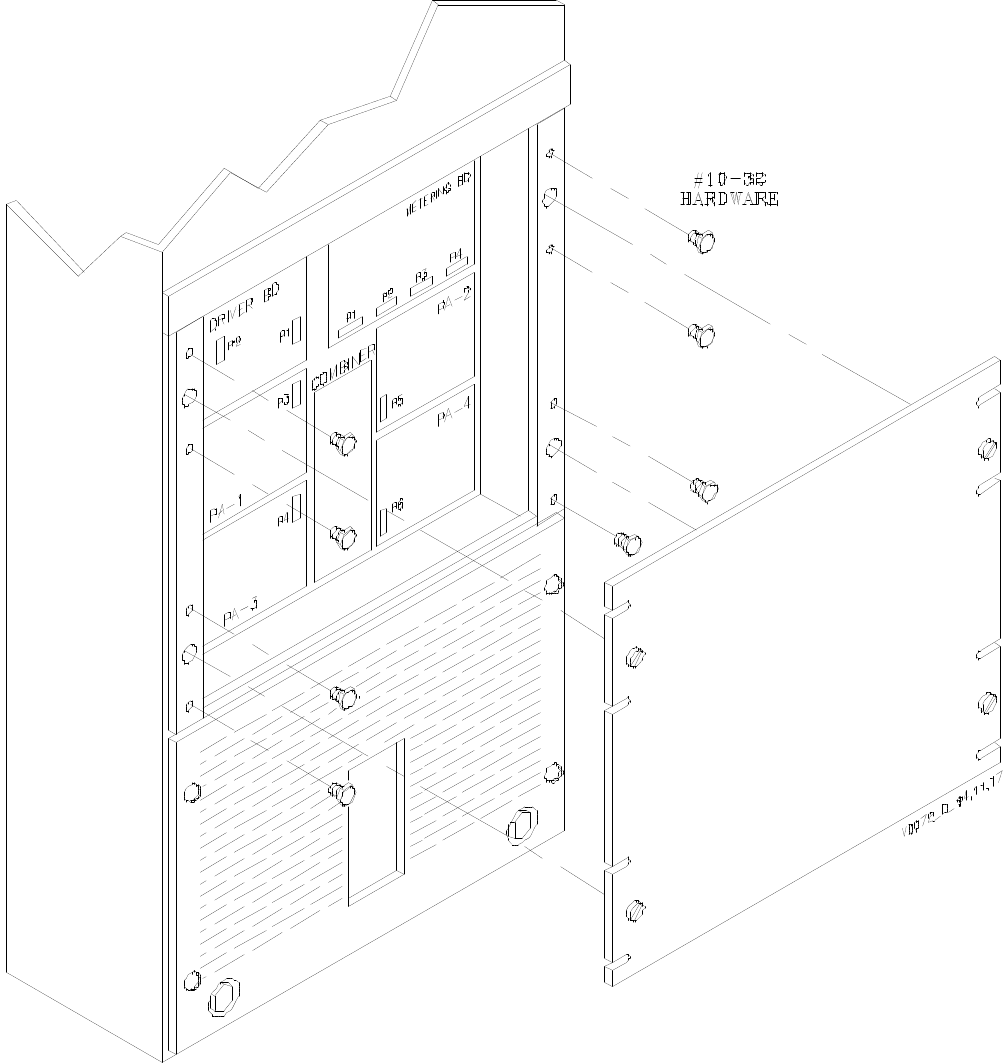
Glenayre Document Number: 9110.00162 250-Watt Gold Line Power Amplifier
Issue 1, Rev. D: 10/21/96 DESCRIPTION
Print Date: 12/17/96 Copyright © 1996 Glenayre Page: 3-3
v0072.hgl
Figure 3-1 500-Watt, 900-MHz Power Amplifier
Front View
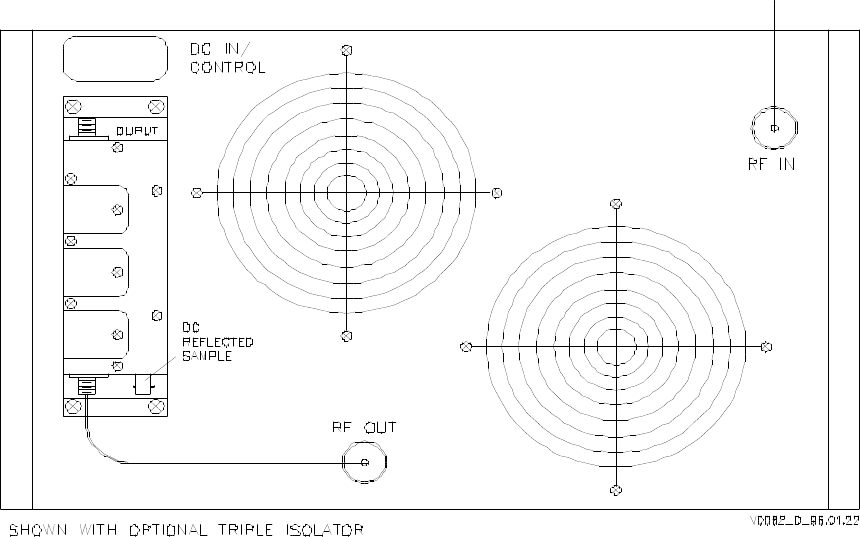
250-Watt Gold Line Power Amplifier Glenayre Document Number: 9110.00162
DESCRIPTION Issue 1, Rev. D: 10/21/96
Page: 3-4 Copyright © 1996 Glenayre Print Date: 12/17/96
v0082.hgl
Figure 3-2 500-Watt, 900-MHz Power Amplifier
Rear View

Glenayre Document Number: 9110.00162 250-Watt Gold Line Power Amplifier
Issue 1, Rev. D: 10/21/96 DESCRIPTION
Print Date: 12/17/96 Copyright © 1996 Glenayre Page: 3-5
3.2.3.2 PA Boards
Four PA boards, PA1, PA2, PA3, and PA4, contain the power amplifiers. The PA boards are
identical but are mounted with different orientations. Each PA board contains an A and a B
pair of power amplifiers. These amplifiers and six resistors are mounted directly on the
PAFan
Two fans provide cooling for the PA and standard isolator. The fan is located within the fan
compartment and is covered by a finger guard. The fan runs continuously whenever power
is applied by the power supply equipment.
3.2.3.3 Equipment Connectors
There are five equipment connectors in addition to those on the isolator. Two 1/4-inch ring
lugs are designated as plus (red) and minus (black). A 9-pin plug-and-socket connector is
designated as P2. A DB15-type connector is designated as PA CONTROL. A BNC
connector is designated as P3.
3.3 Functional Description
Figure 3.3.1 shows a simplified, functional diagram of the PA. The driver, combiner, and
PA boards constitute the RF amplifier circuitry of the PA. Monitoring and controlling this
RF amplifier is the metering board. Figure 3-1 shows the RF amplifier, isolator, and
metering circuitry within the PA.
3.3.1 RF Amplifier
The RF amplifier receives its RF input through the BNC connector P3. A detector circuit
in the RF amplifier monitors this RF input. The RF input is amplified by means of four
amplifier stages. Each amplifier stage receives its dc input power through the metering
circuit. Power detectors at critical locations throughout the RF amplifier provide sample
voltages to the metering circuit. The amplified output of the RF amplifier is applied to the
input type-N connector on the isolator.
3.3.2 Isolator
The isolator prevents intermodulation of the RF signal that may occur from nearby trans-
missions. The RF signal is routed through input and output type N connectors. A detector
circuit in the isolator monitors the reflected power (VSWR) present at the output type-N
connector. A sample voltage representing the VSWR level is output through the BNC
connector. The optional triple isolator functions identically to the standard isolator except
with a higher level of intermodulation prevention.
3.3.3 Metering
The metering board performs control and status reporting for the PA. The metering board
accepts a 25-Vdc power input through the 1/4-inch lugs and a 13.5-Vdc power input
through connector P2. These voltages are regulated and distributed.
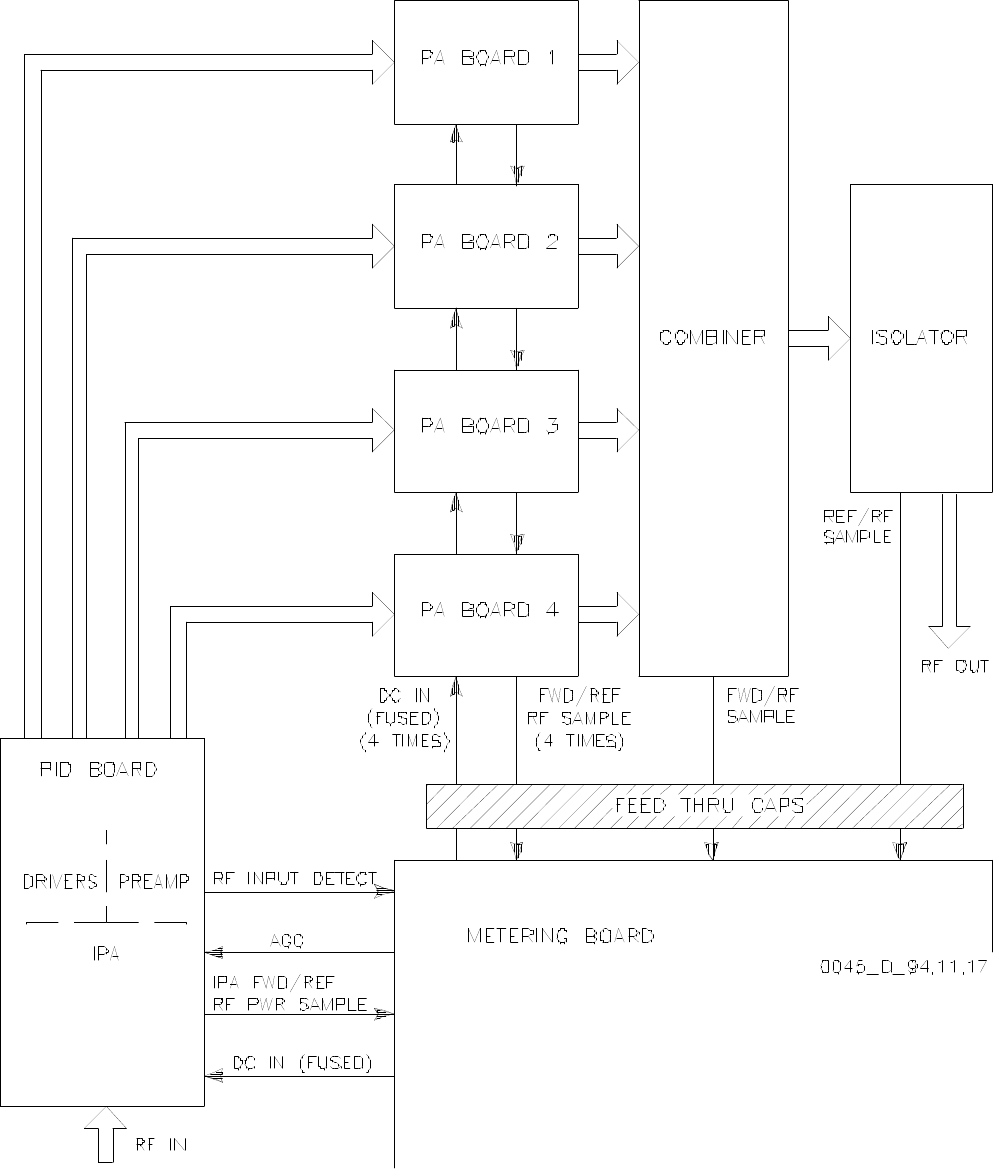
250-Watt Gold Line Power Amplifier Glenayre Document Number: 9110.00162
DESCRIPTION Issue 1, Rev. D: 10/21/96
Page: 3-6 Copyright © 1996 Glenayre Print Date: 12/17/96
v0045.hgl
Figure 3-3 Simplified Block Diagram

Glenayre Document Number: 9110.00162 250-Watt Gold Line Power Amplifier
Issue 1, Rev. D: 10/21/96 INSTALLATION AND SETUP
Print Date: 12/17/96 Copyright © 1996 Glenayre Page: 4-1
4 INSTALLATION AND SETUP
4.1 Precautions and Hazards
Caution
Pc boards within this assembly use static-sensitive
components. Follow IC-handling precautions.
DANGER
The PA chassis is not protected by interlocks.
Disconnect ac power before removing any covers.
4.2 Test Equipment and Tools Required
Refer to Figure 4-1. Equipment listed by brand name may be substituted with equivalent.
Common hand tools are required for assembly and disassembly. An RFI-immune voltmeter
is required for voltage measurement.
4.3 Installation
The PA is shipped already installed in a cabinet. To remove or reinstall the PA, refer to
Section 9.
4.3.1 Rack Positioning
Rackup variations are generally not possible. Cooling and cabling restraints require that
equipment pieces remain racked as shown. Detailed descriptions or equipment mounting
and installation procedures are given in the various equipment user manuals.
Table 4-1 Test Equipment Required
item description
tuning tool Johanson 8777 or equivalent
RF power meter Bird model 8327 or equivalent with appropriate RF
adapters
voltmeter Fluke model 77 DVM or equivalent
RF dummy load 50-ohm load
screwdriver Phillips

250-Watt Gold Line Power Amplifier Glenayre Document Number: 9110.00162
INSTALLATION AND SETUP Issue 1, Rev. D: 10/21/96
Page: 4-2 Copyright © 1996 Glenayre Print Date: 12/17/96
The equipment rack can be placed with its back or sides close to another object since it
ventilates through the front and top. However, to gain reasonable access to the back, 30
inches of free space should be allowed. The top and front of the rack should have at least
ten inches of free space. The cabinet should be placed as close as possible to the transmit-
ting antenna, and to the primary power source as a secondary consideration.
Caution
Never place the rack where moisture, steam,
condensation, or standing water, can come in
contact with it. The host room may need to be air
conditioned or additionally ventilated to remove
excess heat generated by this equipment.
4.3.2 Rack Grounding
The rack cabinet must be connected to a reliable earth ground. Connect the earth ground
point to a ground point provided in the rack; use four-gauge or larger copper conductor.
4.3.3 Equipment Inspection
Inspect the equipment to be certain that the equipment rack is complete. Compare items
received to the packing list. Report shipping loss or damage to carrier within 15 days of
receipt. Remove any packing material from the rack and check each assembly. Pay partic-
ular attention to the power supply; check it closely and remove any foreign material in the
chassis. Be certain to disconnect primary power from the power supply before removing
any equipment covers.
4.3.4 Equipment Cabling
Refer to section four in PN 9110.00163, GL-T8500/GL-T8600 System Manual, for
equipment cabling information.
4.3.5 Equipment Mounting
Refer to Figure 3-1 for information on mounting the PA assembly to the equipment rack.
4.3.6 Ultimate Disposition
Caution
This equipment may contain hazardous materials.
Check with the local EPA or other environmental
authority before disposing of this equipment.

Glenayre Document Number: 9110.00162 250-Watt Gold Line Power Amplifier
Issue 1, Rev. D: 10/21/96 INSTALLATION AND SETUP
Print Date: 12/17/96 Copyright © 1996 Glenayre Page: 4-3
4.4 Setup
Setup of the PA is performed at the system level using an exciter/PA control unit. Refer to
the GL-T8600 system manual. The system manual includes instructions for these appli-
cable setup procedures:
•adjust forward power
•set low power alarm
•calibrate reflected power
250-Watt Gold Line Power Amplifier Glenayre Document Number: 9110.00162
INSTALLATION AND SETUP Issue 1, Rev. D: 10/21/96
Page: 4-4 Copyright © 1996 Glenayre Print Date: 12/17/96

Glenayre Document Number: 9110.00162 250-Watt Gold Line Power Amplifier
Issue 1, Rev. D: 10/21/96 OPERATION
Print Date: 12/17/96 Copyright © 1996 Glenayre Page: 5-1
5 OPERATION
5.1 Controls and Indicators
The PA has one indicator and no controls. Figure 5-1, Front-Panel View with Cover
Removed, shows the location of the PA indicator LED1.
5.2 Operation
5.2.1 Turn PA On and Off
The PA does not contain an on/off switch, but turns on and off whenever the power supply
equipment is turned on and off. When the PA is on, it remains in a standby condition until
keyed. Refer to the power supply manual for turn-on and turn-off procedures.
5.2.2 Turn Fan On and Off
The fan does not contain an on/off switch, but turns on and off whenever the power supply
equipment is turned on and off. The fan runs continuously whenever the power supply
equipment is on. Refer to the power supply manual for turn-on and turn-off procedures.
5.2.3 Key and Unkey PA
The PA does not contain a key switch, but is keyed and unkeyed by the exciter/PA control
equipment. This exciter must be keyed and unkeyed remotely through transmitter
controller, or locally through a video display terminal (VDT). Refer to the controller
manual for remote key and unkey instructions, or to the VDT manual for local key and
unkey instructions.
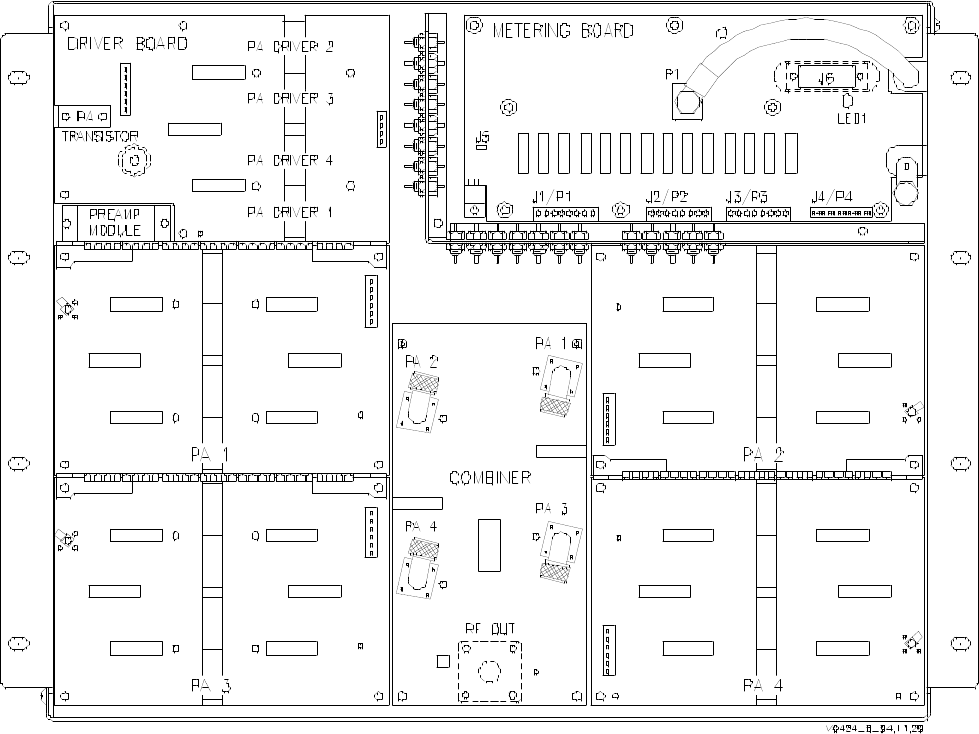
250-Watt Gold Line Power Amplifier Glenayre Document Number: 9110.00162
OPERATION Issue 1, Rev. D: 10/21/96
Page: 5-2 Copyright © 1996 Glenayre Print Date: 12/17/96
v0424.hgl
Figure 5-1 Front-Panel View with Cover Removed

Glenayre Document Number: 9110.00162 250-Watt Gold Line Power Amplifier
Issue 1, Rev. D: 10/21/96 THEORY OF OPERATION
Print Date: 12/17/96 Copyright © 1996 Glenayre Page: 6-1
6 THEORY OF OPERATION
6.1 Power Distribution
The PA requires three separate power inputs: primary 25-volt dc power, secondary 13.5-
volt dc power, and fan 25-volt dc power. All power inputs are normally provided by the
Gold Line power supply.
6.1.1 Primary Power
Refer to Figure 6-2. Primary 25-volt dc operating power is received through the power
cables terminating with 1/4-inch ring lugs. The (-) input (black cable) is bolted directly to
PA chassis ground. The (+) input (red cable) is bolted to P1 on the metering board. P1
powers the +25V power bus on the metering board. This bus distributes primary power to
the metering board and to each common-base collector (CBC) power amplifier in the PA.
6.1.1.1 Metering Board +25V Signal Flow
Refer to Figure 6-4. +25 volts from the power bus is supplied through fuse F13 to these
places on the metering board: LED1, +25V components, divider circuitry, +5V regulator
and divider circuitry, and +1.2V regulator circuitry.
•LED1 activates to illuminate the DC POWER indicator on the front of the PA.
•+25V components receive operating power. These components include the current
detector amplifiers.
•Divider circuit reduces the input to a sample voltage, which determines the PA 25V
metering.
•+5V regulator/divider circuitry generates +5V operating power for the metering board
+5V components. A portion of this +5V is reduced to a sample voltage, which deter-
mines the PA 5V metering.
•+1.2V regulator circuitry generates the compensation voltage for the current detector
amplifiers.
6.1.1.2 Power Amplifiers +25V Signal Flow
Refer to Figure 6-1. +25 volts operating power from the power bus is paralleled through
seven resistors. These resistors are a component of a current detection circuit.
Current-Detection Theory
Current-detection monitoring occurs on the metering board. The monitored current is
routed through a small resistor, resulting in a slight voltage drop across the resistor.
This voltage drop is amplified by a current detector amplifier, which generates an
output voltage proportional to the current flowing through the resistor. This output
voltage is the current sample for the monitored current.

250-Watt Gold Line Power Amplifier Glenayre Document Number: 9110.00162
THEORY OF OPERATION Issue 1, Rev. D: 10/21/96
Page: 6-2 Copyright © 1996 Glenayre Print Date: 12/17/96
The seven monitored +25-volt signals are individually fused before leaving the metering
board. The signals provide operating power for power amplifiers located on the driver and
PA boards. Each signal is routed through a dc bias network.
6.1.2 Secondary Power
Secondary 13.5-volt dc power for the PA is externally fused, at the power supply equip-
ment. Refer to Figure 6-1. Secondary power is received through connector P2, which
mates with J2 on the system interconnect harness. Secondary power is connected to J5 on
the metering board. The +13.5 input from J5 is distributed to the metering board and the
preamp module.
6.1.2.1 Metering Board +13.5V Signal Flow
Refer to Figure 6-2. +13.5-volt power from J5 is paralleled to these places on the metering
board: +13.5V components, divider circuitry, and heat sink temperature transducer U17.
•+13.5V components receive operating power. These components include those within
the AGC integrator circuit.
•Divider circuit reduces the input to a sample voltage, which determines the system PA
13.5V metering.
•Heat-sink-temperature transducer U17 generates a voltage proportional to the tempera-
ture of the PA heat sink, which determines the temperature metering.
6.1.2.2 Preamplifier Module +13.5V Signal Flow
Refer to Figure 6-2. +13.5-volt power from J5 is routed through a resistor, a component of
a current-detection circuit. The sample provided by this circuit determines the preamplifier
current metering. The +13.5-volt power through the resistor is fused by F4 before distribu-
tion to the metering board and preamplifier module, on the driver board.
6.1.3 Fan Power
25-volt dc fan power is fused externally at the power supply equipment. Refer to Figure 6-
1. Fan power is received through connector P2, which mates with J2 on the system inter-
connect harness. Fan power is applied directly to the fan via a quick-release jack (not
shown).
Dc-Bias Network Theory
Dc bias networks are located on the driver board and PA boards. +25-volt operating
power from the metering board is applied to the power amplifiers through a dc bias
network. The network is tuned and filtered to cause a high impedance to signals from
dc to above operating frequency. This prevents RF from transmitting backwards into
the metering board.

Glenayre Document Number: 9110.00162 250-Watt Gold Line Power Amplifier
Issue 1, Rev. D: 10/21/96 THEORY OF OPERATION
Print Date: 12/17/96 Copyright © 1996 Glenayre Page: 6-3
6.2 RF Distribution
Refer to Figure 6-1. The PA RF input is received through a BNC connector, which mates
with J3 on the exciter/PA control. This RF input signal (at a nominal 350 mW) is split and
amplified into two RF signals (at a nominal 40 watts) by the driver board. Each RF signal
is amplified (to a nominal 150 watts) by a PA board. These RF signals are combined into
one RF signal (at a nominal 550 watts) by the combiner board. This is the PA RF output,
and is applied to an isolator. The isolator RF output (at a nominal 500 watts for standard)
is supplied to an antenna for transmission. All power levels given here and in the following
paragraphs are typical; actual power levels will vary from those given.
6.2.1 Driver Board RF Flow
The driver board splits and amplifies a 350-mW RF input into four 40-watt RF outputs.
Refer to Figure 6-3. The RF input to the driver board is applied to the preamplifier module
(Q1). A portion of the RF input is applied to an RF-detection circuit on the board. This
circuit rectifies and filters the RF input into an OK signal. Loss of the RF input and the OK
signal results in an exciter output fault.
The preamplifier module is a three-stage RF power amplifier on a single IC. The first and
third stages are powered by an AGC signal. These are the variable gain stages, and control
the forward power output of the PA. The first and third stages of the preamp module are
powered by an AGC signal, generated on the metering board. AGC signal voltage is
monitored for status only. The second stage of the preamplifier module is a nonvariable-
gain stage, powered by +13.5-volt power. The current drawn by the AGC and +13.5-volt
power signals contributes to the preamplifier current metering.
The amplified RF output from the preamp module is applied to the IPA (Q2). The current
drawn from the IPA’s +25-volt power source is monitored to determine the IPA current
metering. The amplified RF output from the IPA is monitored for forward and reflected
power levels. The power samples detected at this location determine the IPA forward - and
reflected-power metering.
After monitoring, the amplified RF output from the IPA is split in four by means of an RF
splitter, commonly known as a Wilkinson splitter. The four split RF signals are applied to
driver-1 (Q3), driver-2 (Q4), driver-3 (Q5), and driver-4 (Q6). The current drawn from each
Power-Monitoring Theory
Power-monitor circuits are located on the driver board, PA boards, and combiner
board. A microstrip line parallel to the RF signal path couples a small portion of the ac
signal across a rectifier and filtering circuit. The ac signal may be rectified to detect
either the forward or reflected power. After filtering, a dc sample voltage is available
that is proportional to the power detected at the monitored location.

250-Watt Gold Line Power Amplifier Glenayre Document Number: 9110.00162
THEORY OF OPERATION Issue 1, Rev. D: 10/21/96
Page: 6-4 Copyright © 1996 Glenayre Print Date: 12/17/96
driver’s +25-volt power source is monitored to determine the driver-1, driver-2, driver-3,
and driver-4 current metering. The amplified RF outputs from the four drivers are the driver
board’s 40-watt RF outputs.
6.2.2 PA Board RF Flow
Each PA board amplifies a 40-watt RF input into a 150-watt RF output. Refer to Figure 6-
3. The RF input to the PA board is split into four signals by means of three Wilkinson split-
ters. Each RF signal drives a power amplifier, for a total of four amplifiers (Q1, Q2, Q3,
and Q4). Q1 and Q2 receive operating power from a common +25-volt power source. The
current drawn by this source is monitored to determine the PA board’s A-pair current.
Likewise, the current drawn by Q3 and Q4 common +25-volt power source is monitored to
determine the PA board’s B-pair current.
The amplified RF outputs from the four power amplifiers are combined into one by means
of three Wilkinson combiners. The RF signal from the last Wilkinson combiner is
monitored for forward and reflected power levels. The power samples detected at this
location determine the PA board’s forward and reflected power metering. The combined
and monitored RF signal is the PA board’s 150-watt RF output.
6.2.3 Combiner Board RF Flow
The combiner board combines four 150-watt RF inputs into a single 550-watt RF output.
Refer to Figure 6-3. The four RF inputs are combined by a Wilkinson combiner. The
combined RF is monitored for forward power level. The power sample detected at this
location determines the total forward power metering. The combined and monitored signal
is the combiner board’s 550-watt RF output.
6.2.4 Isolator RF Flow
The isolator conducts its 550-watt RF input only in the forward direction, suppressing any
intermodulation or VSWR present at its RF output. Refer to Figure 6-3. The RF input is
applied through a circulator. The optional triple isolator RF input is applied through three
circulators.
Wilkinson Splitter/Combiner Theory
Wilkinson splitter and combiner networks are located in the RF signal path on the
driver board, PA boards, and combiner board. A waster resistor is located a precise
distance from the signal junction. This resistor dissipates any out-of-phase imbalance
or amplifier imbalance that may exist between the RF signals being split or combined,
resulting in a more stable amplifier.
Circulator Theory
A circulator consists of several circular layers of copper, ferrite, and a magnetic
material that biases the ferrite. The circulator has three inputs/outputs. The biased
ferrite conducts electricity only in one direction, outputting the signal applied at its
previous input. Each circulator provides 25 dB of isolation.

Glenayre Document Number: 9110.00162 250-Watt Gold Line Power Amplifier
Issue 1, Rev. D: 10/21/96 THEORY OF OPERATION
Print Date: 12/17/96 Copyright © 1996 Glenayre Page: 6-5
The circulator RF output is applied through a notch filter to remove the second harmonics
generated by the circulator. This filtered RF is the isolator’s RF output. This RF output is
typically 500 watts for a standard isolator. Any reflected power present at the isolator RF
output is conducted back through the circulator to a rectifier and filtering circuit. This
circuit generates a dc sample voltage proportional to the VSWR present at the isolator RF
output. The sample voltage determines the total reflected-power metering.
6.3 Control Distribution
Refer to Figure 6-1. The PA control inputs are received through a DB15 connector, which
mates with J6 on the exciter/PA control. Two types of control inputs are received: AGC
reference and multiplexer.
6.3.1 AGC Signal Flow
The metering board compares the AGC reference signal (from the exciter) with the total
forward power sample (from the combiner board) to create an AGC signal (to the driver
board). Refer to Figure 6-2. The AGC reference signal and the total forward power sample
are applied to an integrator circuit, which generates the AGC signal. An increase in the
AGC reference signal or a decrease in the total forward power sample causes an increase
in the AGC signal. This AGC signal provides operating power for the first and third
amplifier stages of the preamplifier. Divider circuitry reduces a portion of the AGC signal
to a sample voltage, which determines the AGC metering.
6.3.2 Multiplexer Control Signal Flow
Refer to Figure 6-2. The exciter controls each multiplexer by four control lines: three
address lines and a latch. The address lines (0, 1, and 2) are binary signals with a total of
eight possible states. The address lines sequence through the eight states in about 360
microseconds. As each state occurs, the latch line is toggled, selecting the analog input
corresponding to that address state. The voltage present at the multiplexer common output
is the most recently latched analog input.
6.4 Status Distribution
Refer to Figure 6-1. The PA status outputs are supplied through the same DB15-type
connector as the PA control inputs, which mates with J6 on the exciter/PA control. Two
types of status outputs are supplied: multiplexed (mux) analog and PA fault.
Analog Multiplexer Theory
Three analog multiplexers are located on the metering board. Each multiplexer re-
ceives as many as eight analog inputs, at a sample voltage which represents a PA
parameter or status. Control lines from the exciter command the multiplexer to connect
one of the inputs to a common output, which is measured by the exciter. The multi-
plexer is switched quickly between the analog inputs, resulting in a multiplexed analog
output.
250-Watt Gold Line Power Amplifier Glenayre Document Number: 9110.00162
THEORY OF OPERATION Issue 1, Rev. D: 10/21/96
Page: 6-6 Copyright © 1996 Glenayre Print Date: 12/17/96
6.4.1 Mux Analog Status Signal Flow
Mux analog status signals consist of dc voltages that represent a parameter or fault within
the PA. These signals are generated by current detectors, power monitors, and metering
dividers, which supply a status voltage proportional to the level of parameter it is repre-
senting, or the existence of the fault it is representing. Refer to Figure 6-2. These status
voltages are applied to one of the three multiplexers located on the metering board. The
multiplexers route the appropriate status voltage to the exciter in the form of mux analog.
Table 6-1 lists all status voltage nomenclature, the multiplexer that routes that voltage, and
the control address that directs the multiplexer to route that voltage.
6.4.2 PA Fault Signal Flow
A PA fault signal is activated when a reflected power threshold is exceeded by the PA1,
PA2, PA3, and PA4 board. Refer to Figure 6-2. A portion of the PA1, PA2, PA3, and PA4
board reflected power status voltages are applied to a comparator and switching circuit.
When either status exceeds a voltage representing about 20 watts, the switch is activated.
The switch applies a PA fault to the exciter, which shuts down the transmitter.

Glenayre Document Number: 9110.00162 250-Watt Gold Line Power Amplifier
Issue 1, Rev. D: 10/21/96 THEORY OF OPERATION
Print Date: 12/17/96 Copyright © 1996 Glenayre Page: 6-7
Table 6-1 Multiplexer Analog Status Inputs
addr multiplexer 1 multiplexer 2 multiplexer 3 multiplexer 4
000 PA1-A current PA1 forward power +13.5V voltage level AGC voltage level
001 PA1-B current PA1 reflected power IPA current (no input)
010 PA2-A current PA2 forward power driver-1 current IPA forward power
011 PA2-B current PA2 reflected power driver-2 current IPA reflected power
100 PA3-A current PA3 forward power driver-3 current (no input)
101 PA3-B current PA3 reflected power driver-4 current (no input)
110 PA4-A current PA4 forward power exciter output fault (no input)
111 PA4-B current PA4 reflected power AGC voltage level (no input)
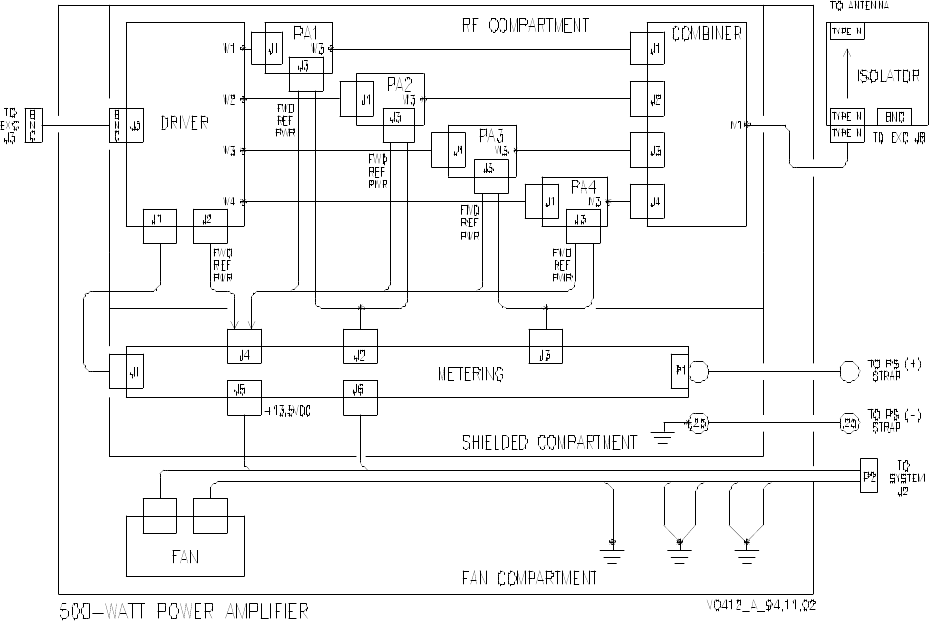
250-Watt Gold Line Power Amplifier Glenayre Document Number: 9110.00162
THEORY OF OPERATION Issue 1, Rev. D: 10/21/96
Page: 6-8 Copyright © 1996 Glenayre Print Date: 12/17/96
v0412.hgl
Figure 6-1 500-Watt PA Interconnection Diagram
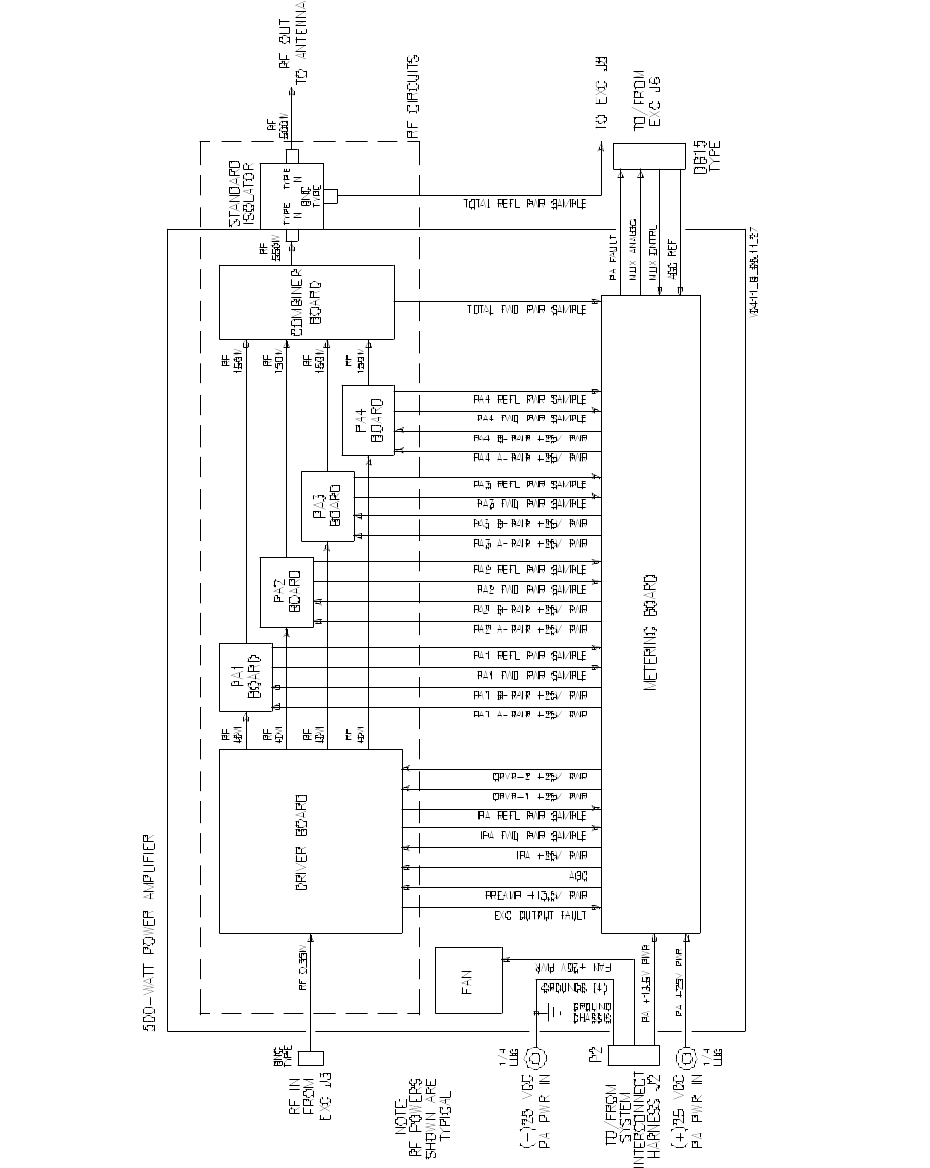
Glenayre Document Number: 9110.00162 250-Watt Gold Line Power Amplifier
Issue 1, Rev. D: 10/21/96 THEORY OF OPERATION
Print Date: 12/17/96 Copyright © 1996 Glenayre Page: 6-9
v0411.hgl
Figure 6-2 500-Watt PA Functional Diagram
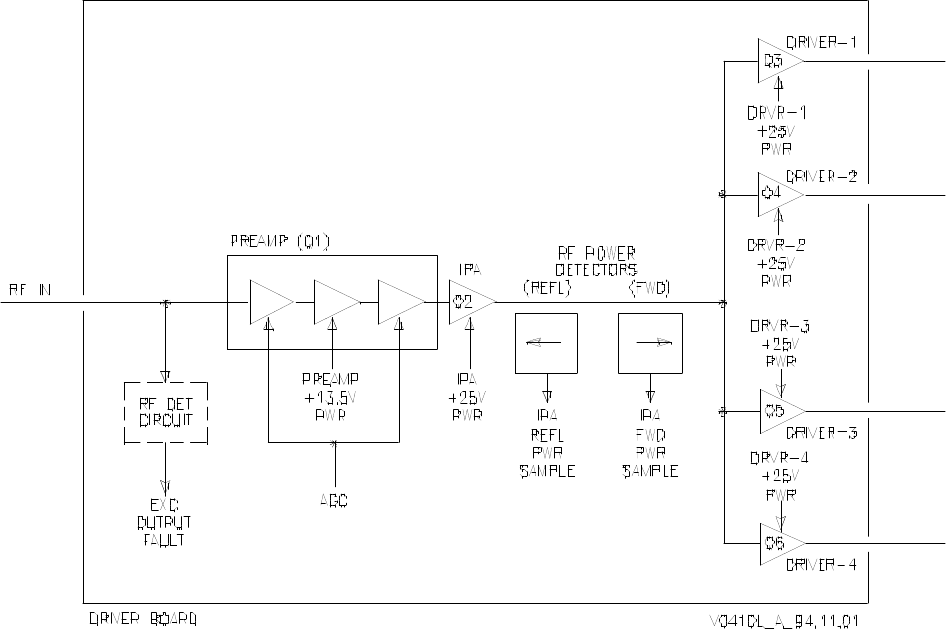
250-Watt Gold Line Power Amplifier Glenayre Document Number: 9110.00162
THEORY OF OPERATION Issue 1, Rev. D: 10/21/96
Page: 6-10 Copyright © 1996 Glenayre Print Date: 12/17/96
v0410l.hgl
Figure 6-3 500-Watt PA Detailed Functional Diagram
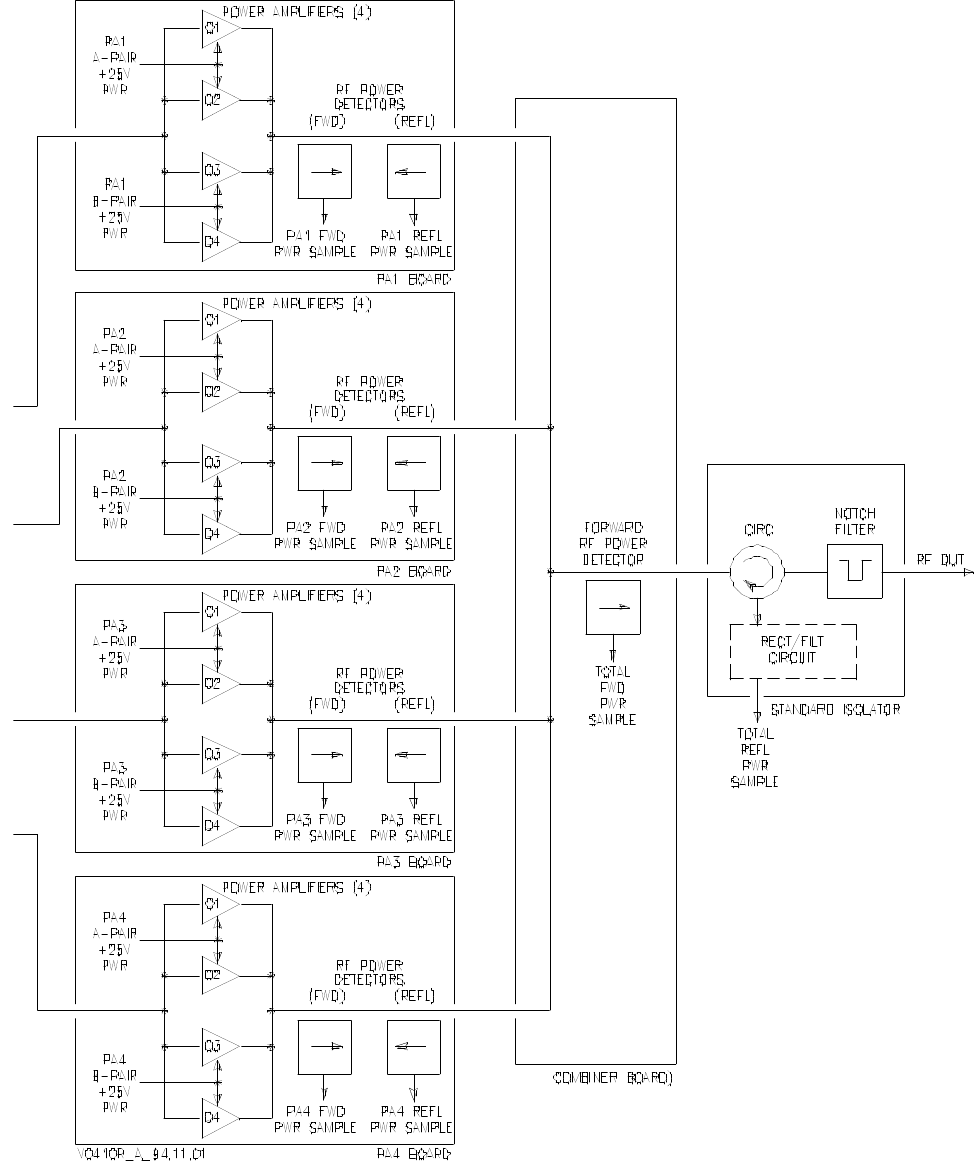
Glenayre Document Number: 9110.00162 250-Watt Gold Line Power Amplifier
Issue 1, Rev. D: 10/21/96 THEORY OF OPERATION
Print Date: 12/17/96 Copyright © 1996 Glenayre Page: 6-11
v0410r.hgl
Figure 6-3 500-Watt PA Detailed Functional Diagram (continued)
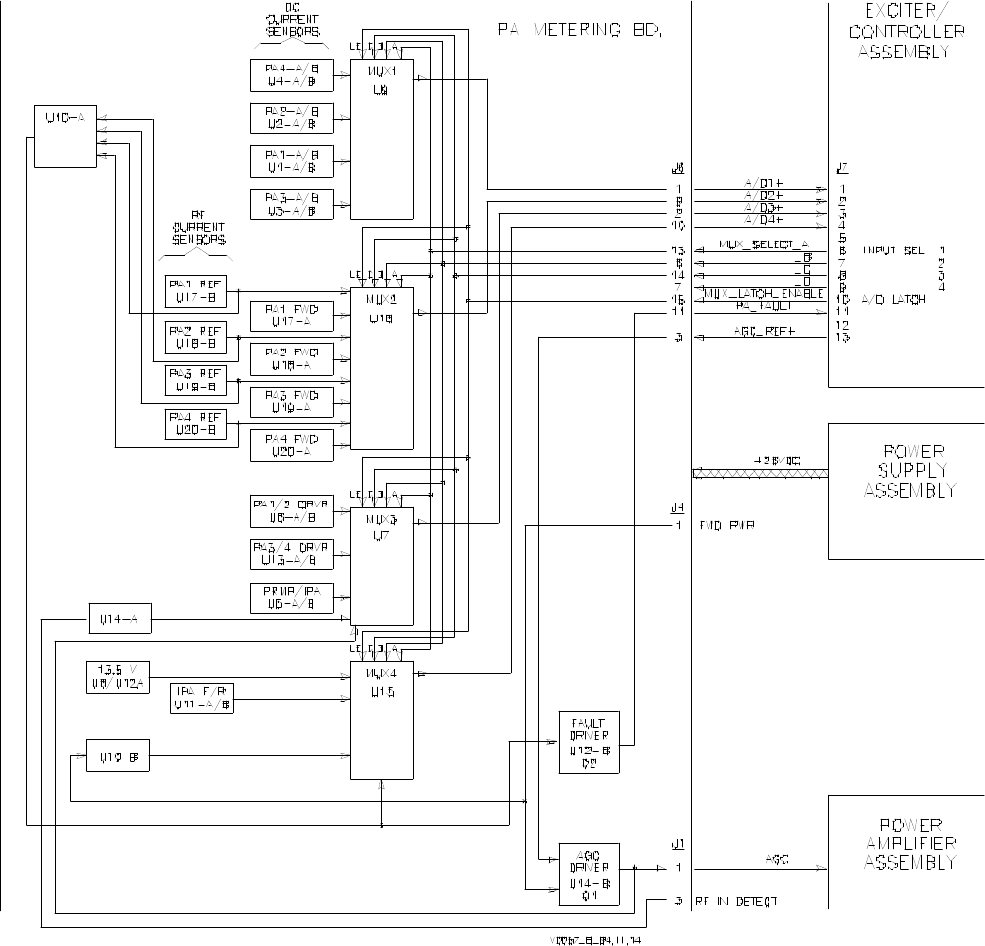
250-Watt Gold Line Power Amplifier Glenayre Document Number: 9110.00162
THEORY OF OPERATION Issue 1, Rev. D: 10/21/96
Page: 6-12 Copyright © 1996 Glenayre Print Date: 12/17/96
v0057.hgl
Figure 6-4 Metering Board Functional Diagram

Glenayre Document Number: 9110.00162 250-Watt Gold Line Power Amplifier
Issue 1, Rev. D: 10/21/96 MAINTENANCE
Print Date: 12/17/96 Copyright © 1996 Glenayre Page: 7-1
7 MAINTENANCE
Refer to the system and VDT manuals.
250-Watt Gold Line Power Amplifier Glenayre Document Number: 9110.00162
MAINTENANCE Issue 1, Rev. D: 10/21/96
Page: 7-2 Copyright © 1996 Glenayre Print Date: 12/17/96

Glenayre Document Number: 9110.00162 250-Watt Gold Line Power Amplifier
Issue 1, Rev. D: 10/21/96 CHECKOUT AND TROUBLESHOOTING
Print Date: 12/17/96 Copyright © 1996 Glenayre Page: 8-1
8 CHECKOUT AND TROUBLESHOOTING
Refer to the system and VDT manuals.
250-Watt Gold Line Power Amplifier Glenayre Document Number: 9110.00162
CHECKOUT AND TROUBLESHOOTING Issue 1, Rev. D: 10/21/96
Page: 8-2 Copyright © 1996 Glenayre Print Date: 12/17/96

Glenayre Document Number: 9110.00162 250-Watt Gold Line Power Amplifier
Issue 1, Rev. D: 10/21/96 REMOVAL AND REINSTALLATION
Print Date: 12/17/96 Copyright © 1996 Glenayre Page: 9-1
9 REMOVAL AND REINSTALLATION
9.1 PA Chassis Removal and Reinstallation
Figure 9-1 shows details of removing and reinstalling the chassis. Calibration of forward
and reflected power is required after reinstallation.
9.2 PA RF Module Removal and Reinstallation
Figure 9-2 shows details of removing and reinstalling PA RF modules.
9.3 Metering Board Removal and Reinstallation
Figure 9-3 shows details of removing and reinstalling the metering board.
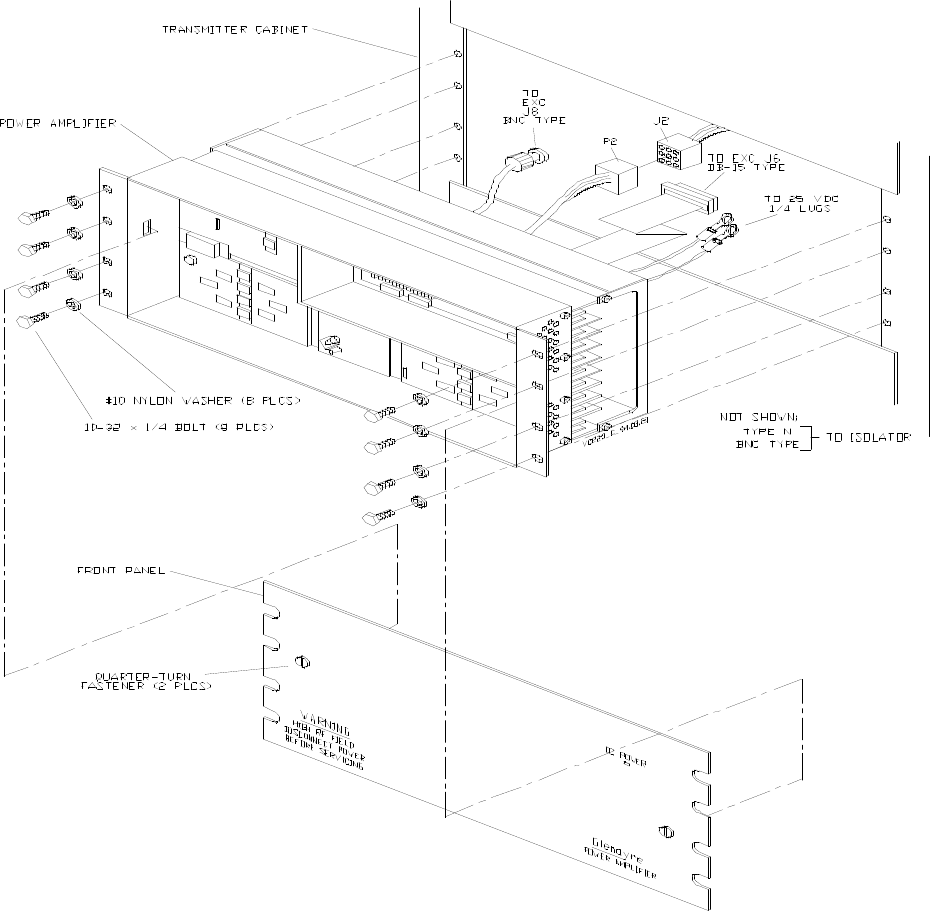
250-Watt Gold Line Power Amplifier Glenayre Document Number: 9110.00162
REMOVAL AND REINSTALLATION Issue 1, Rev. D: 10/21/96
Page: 9-2 Copyright © 1996 Glenayre Print Date: 12/17/96
v0223.hgl
Figure 9-1 PA Removal and Reinstallation
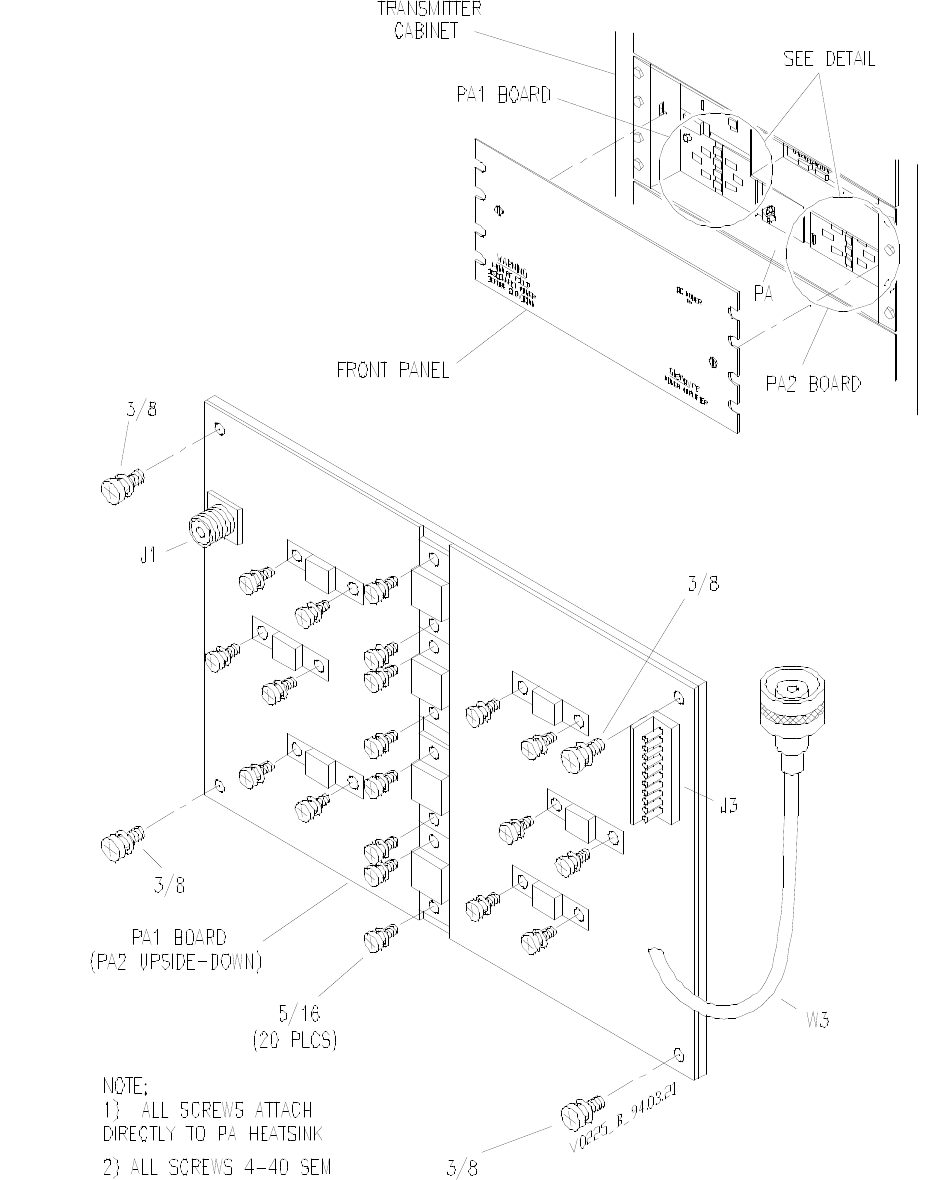
Glenayre Document Number: 9110.00162 250-Watt Gold Line Power Amplifier
Issue 1, Rev. D: 10/21/96 REMOVAL AND REINSTALLATION
Print Date: 12/17/96 Copyright © 1996 Glenayre Page: 9-3
v0225.hgl
Figure 9-2 PA RF Module Removal and Reinstallation
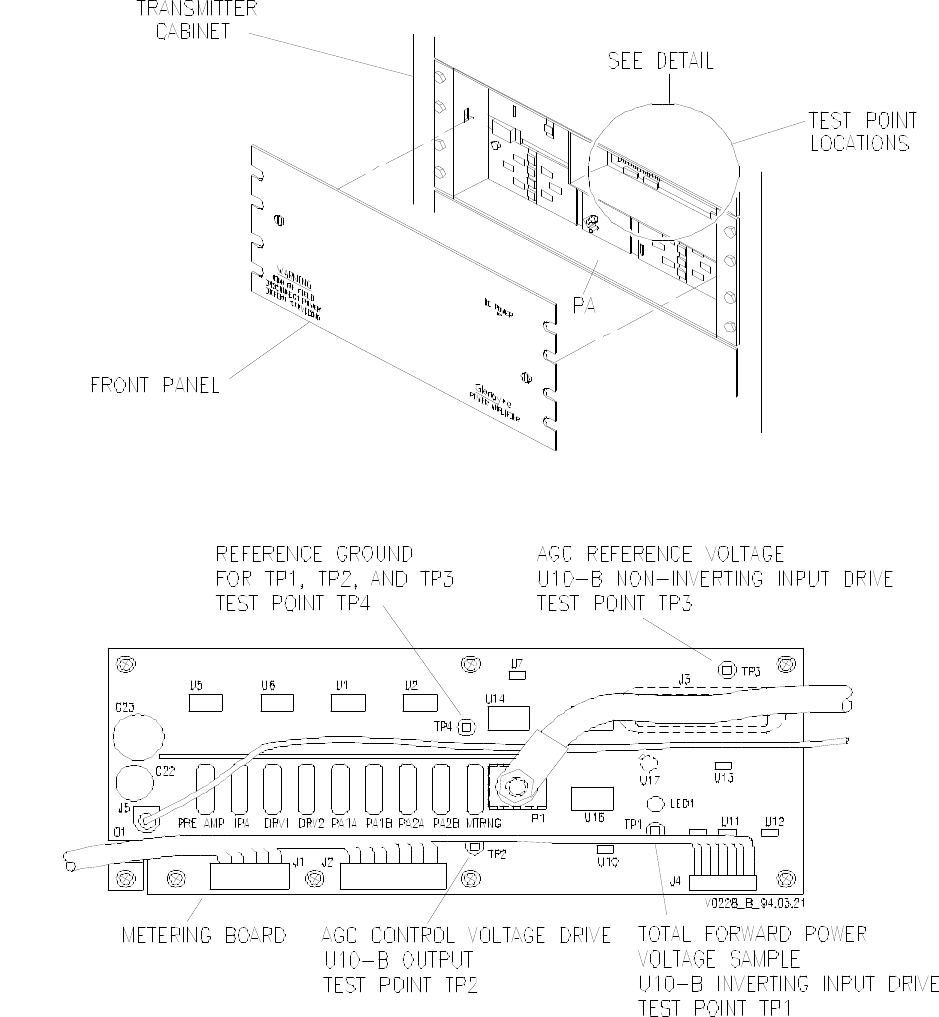
Glenayre Document Number: 9110.00162 250-Watt Gold Line Power Amplifier
Issue 1, Rev. D: 10/21/96 REMOVAL AND REINSTALLATION
Print Date: 12/17/96 Copyright © 1996 Glenayre Page: 9-5
v0228.hgl
Figure 9-3 Metering Board Removal and Reinstallation
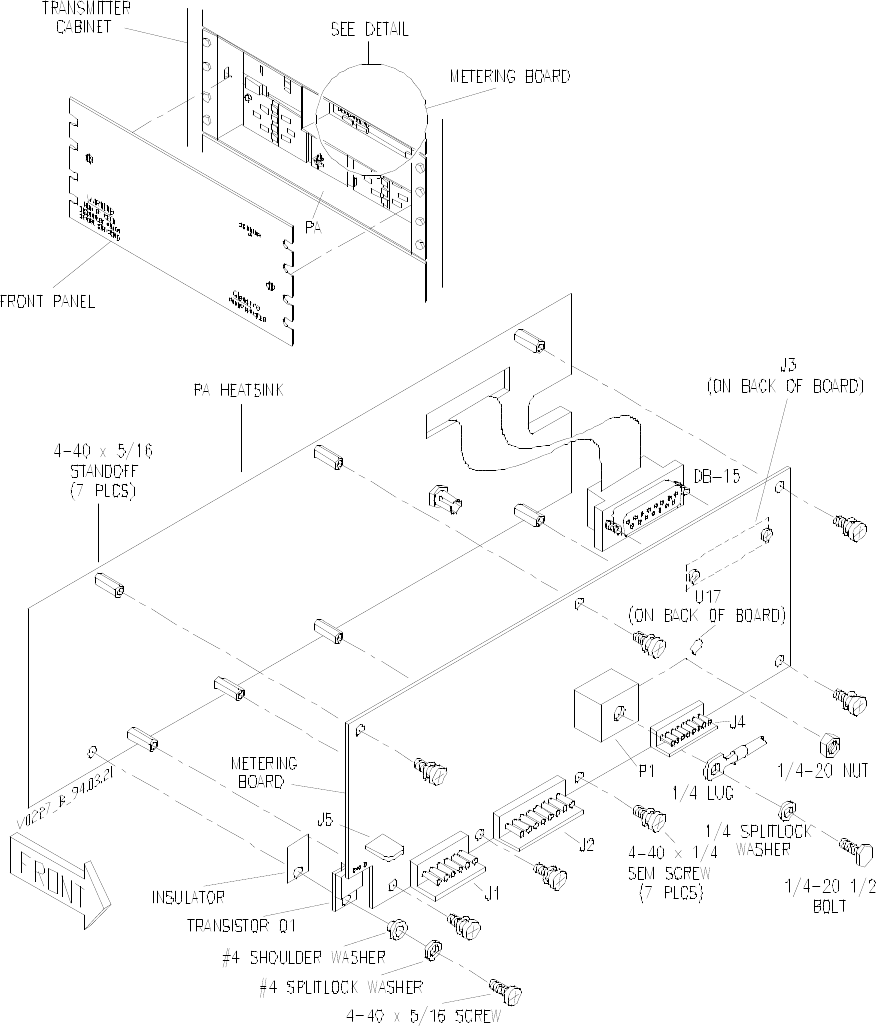
250-Watt Gold Line Power Amplifier Glenayre Document Number: 9110.00162
REMOVAL AND REINSTALLATION Issue 1, Rev. D: 10/21/96
Page: 9-6 Copyright © 1996 Glenayre Print Date: 12/17/96
v0227.hgl
Metering Board Removal and Reinstallation (continued)
